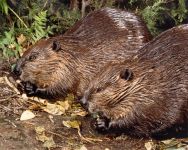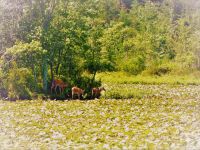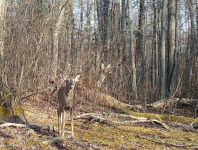


|

|
|
 
|


In some cases where deer are located in a finite area, contraception may be the best way to keep deer numbers consistent with the carrying capacity of the habitat. Because a reduction in numbers will take time, people need to be patient. Some of the methods that can be considered include immunocontraception (Anon 2015; Rutberg et al 2013) and spaying (Basch 2013; Hendrix 2014).
When deer threaten people's gardens, appropriate fencing and repellents (Andelt et al 1994) can be used. If a fence is tall enough, it can be 100% effective in preventing access by deer (VerCauteren et al 2010). There are explicit instruction sheets on how to install fencing to be effective (Grande et al 2010). In some cases, like in New Jersey, government agencies provide non-lethal solutions, primarily through subsidized fencing (Drake et al 2001). Information on how to apply for the New Jersey program can be found on the State Agriculture Development Committee page. It is important to know the limitations of some repellents (Bíl et al 2018; Kimball et al 2009). People can choose to use plants that are not attractive to deer rather than insisting on those that will continue to create conflicts.
Collisions with cars can be reduced by posting speed limits that take into account area-specific risks to wildlife, adherence to and enforcement of these limits, and driver education about why collisions occur (O'Keefe & Rea 2012). Be aware, however, that certain repellent methods such as warning reflectors (D'Angelo et al 2006), touted by manufacturers, have been shown to be ineffective. Anecdotal data suggest that sometimes hunting may increase collisions because deer leave their normal territories to seek safety elsewhere, crossing roads in the process (Scully 2008).
Lyme disease or borreliosis, although important, is not spread by deer. Deer, as well as other animals, are hosts to the species of tick that sometimes contains the organism that causes Lyme disease (Borrelia burgdorferi). People can be infested by the tick in the same way deer are, by walking through areas where the ticks reside. Wearing protective clothing and using an appropriate repellent can reduce the chance of infestation. The risk of infection from a potentially infectious tick can be further reduced or eliminated entirely by always checking oneself for the presence of ticks and promptly removing them.
In addition to the above and the references below, you can visit CayugaDeer.org - Ithacans for Safe, Ethical, and Rational Approaches to Reducing Deer-Human Conflict. This group has done considerable research on the issue and provides information that can be applied in most situations.
The following references provide non-lethal means of reducing the negative impact of deer on the property of people. They are ordered by publication date, with latest at the top. These are provided in the spirit of urging people to use only non-lethal measures when deer-human conflicts occur, but Unexpected Wildlife Refuge does not necessarily endorse every measure listed:
This short document brief discusses fencing, including high-tensile woven fence and portable electric fences. With the latter they recommend using a "trap crop" to keep the deer distracted from the highly valued crops.
The online version of this document contains a link to a short video on fence installation.
Maintaining a trap crop such as young soybeans to drawn deer away from high-value crops may enhance the effectiveness of portable electric fencing.
The single-shot, multi-year GonaCon™ vaccine will be a useful technique for the management of certain enclosed or urban/suburban wildlife populations, such as deer.
We applied a Bayesian approach as only a limited numbers of WVC were available. A WVC decrease between 26 – 43% can be expected on the treated road sections. These numbers are, however, up to three-times lower than those claimed by producers of odor preparations.
Although the study was done in the Czech Republic on roe deer and wild boar, the data are likely to be translatable to other situations.
Useful, brief information on types of fencing that can be used for deterring deer.
Provides succinct information on how to discourage deer from entering yards by using plants that are unattractive to them.
Provides information on species of plants that are not palatable or otherwise attractive to deer.
Three temporary, non-lethal methods were evaluated: 1) a polyrope electric fence, 2) Plantskydd™ (chemical repellent) and 3) a winged fence. The polyrope electric fence was most effective.
Polyrope electric fences may be a suitable tool in areas where wildlife management agencies want to maintain deer and elk populations but reduce seasonal damage by cervids to high-value crops. In Colorado, use of an effective exclusion technique such as polyrope electric fence could also decrease the need for lethal depredation permits and damage compensation payments, and increase satisfaction among producers and the public.
A research permit from the Maryland Department of Natural Resources allows the approach. In 2011, the program's first year, 32 does were sterilized. 'This alone, by doing the 32 does, will prevent the birthing of probably 300 fawns during the does' eight-year reproductive life, says Feinberg [Enid Feinberg, volunteer president of the nonprofit group Wildlife Rescue, Inc.]...'we found that because the deer are no longer pregnant, they're no longer consuming the amount of food that they were. So the browsing and the food consumption has dropped tremendously without having to do any harm to the deer,' she adds.
Most vaccine preparations tested reduced fawning rates by 75% to 95% for at least 1 yr. From 2005 to 2011, deer density on Fripp Island declined by 50%, from 72 deer/km2 to 36 deer/km2, an average annual reduction of 11%.
We stress the importance of using these data in the development of driver awareness campaigns and discuss their importance in understanding the ecologies of animals being struck and the development of regional- and species-specific mitigation plans.
Evaluated a special electrified fence that was 1.2 meters tall. They found that it was effective, although they recommended other methods for permanent deterrence.
...the fence could be effective as immediate protection of stored feed in winter before a more permanent and effective deterrence strategy, such as woven-wire fencing, could be installed during the subsequent summer. The fence would also be effective for reducing deer depredation of stored feed, as well as gardens, small orchards, or other localized or seasonal resources.
The authors discuss materials and methods to install high-tensile woven wire fencing so that it is effective and relatively maintenance-free.
Fences that were 2.4 meters (~ 7 feet 11 inches) high (commonly used at captive deer facilities) were 100% effective in preventing deer from clearing them. The next most effective height tested was 2.1 meters and was 85% effective.
Researchers are proposing in a new report that a major experiment be conducted to reintroduce wolves to a test site in the Scottish Highlands, to help control the populations and behavior of red deer that in the past 250 years have changed the whole nature of large ecosystems.
…scientists point not just to the effect of large predators in helping to control the populations of grazing animals, but also their behavior. The threat of predation and attack can fundamentally change the movement and activities of grazing animals 24 hours a day, 365 days a year, in ways that such approaches as human hunting fail to do.
The native red deer in Scotland – essentially the same animal as elk in the United States – have not faced predation or fear such as that for 250 years. Deer densities in that country are now thought to be so high they are close to the food-limiting carrying capacity of the land, and have serious consequences on native Scots pine and birch regeneration.
These data support previous studies indicating that habituation to odor limits the effectiveness of repellents that are not applied directly to food, while topically-applied irritants and animal-based products produce significant avoidance.
Thus, wolf restoration holds promise for enhancing ungulates populations by reducing coyote predation rates on neonates of species such as pronghorn, mule deer, and white-tailed deer.
To the extent that large carnivores exert top-down forces on systems, our results suggest that their loss or removal may result in unanticipated effects on ecological communities that may lead to further decreases in biodiversity.
...the deer spring into busy unfenced roads in flight from hunters. Indeed, a study in Pennsylvania found that car insurance claims for deer-related accidents increase fivefold during hunting season.
We concluded that wildlife warning reflectors were ineffective in changing deer behavior such that deer–vehicle collisions might be prevented.
Under the conditions and time duration of this test, the fence was an effective deer barrier.
We describe an interactive, dynamic simulation model that conducts economic analyses and predicts economic benefit associated with fences for crops relative to area and perimeter of protected plot, value of crop, percentage of crop damaged by deer annually prior to fencing, efficacy of fence, and costs of fence materials and labor.
This is a review of the scientific literature on which means of fencing is effective in deterring deer. They concluded the following:
When tolerance for deer penetration is low...wovenwire fence should be the only practiced option. If complete exclusion is not necessary and the cost of fence is an issue, a multistrand, electrified, high-tensile wire fence may be sufficient. For seasonal protection, an affordable and easily installed, electric poly-fence may be a reasonable alternative.
The authors tested the effectiveness of a 'scarecrow' that popped up when triggered by deer. Although effective initially, the deer eventually became habituated to the device. The conclusion is that this method can be useful in the short term.
The authors surveyed farmers who had been recipients of high-tensile woven wire fence and smooth wire to place along the top of installed fencing. They also visited farms where the fencing was installed (by the farmers or by commercial installers) to evaluate the quality of the installations, and made observations on problems they saw.Ninety-nine percent of survey respondents indicated that they experienced crop damage by white-tailed deer prior to installing the fence...After installing the fence, 96% of respondents stated that they experienced a reduction in crop damage, with only 4% of respondents estimating crop losses exceeding $5,000. Forth-eight percent of respondents indicated that they experienced no deer damage once the fence was installed.
...a 6.2% concentration of Hot Sauce (100 times the concentration labeled for deer) and BGR [Big Game Repellent] reduced (P < 0.05) consumption relative to the control and other repellents. Although the 6.2% concentration of Hot Sauce and BGR were the most effective browsing deterrents, their effectiveness may be relatively short lived if deer are continually exposed to them.
Discusses the issues surrounding various fencing schemes. Given that there are more current studies, this reference is mainly for some background.
The authors evaluated the use of electrified fences, combined with attractants or repellents.
Data from 116 days indicate that the electric fence with a repellent excluded deer most effectively. Deer penetrated this type of exclosure only once. Electricity and attractant ranked second, and electricity alone ranked third in effectiveness for excluding deer.